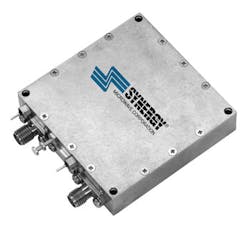Download this article as a .PDF
Fifth-generation (5G) wireless networks may be a year or two away, but the growing demands for wireless functionality from current fourth-generation (4G) Long Term Evolution (LTE) wireless communications systems are creating near-supernatural expectations for 5G wireless networks. To handle massive amounts of data along with their voice and video services, 5G networks will need to occupy spectrum at 28 GHz and higher and use advanced transmission formats, such as time-division-duplex (TDD) techniques, to transfer information-laden signals.
Wireless systems built to meet these high expectations will need stable and quiet frequency synthesizers operating at these higher frequencies. One such example is the model KSFLO27T50-12-100 phase-locked oscillator from Synergy Microwave Corp. It has been designed to provide stable, low-noise mixing signals for frequency translation of 28-GHz 5G signals, as well as for mixing with signals from Ka-band radar systems. The device delivers low-phase-noise signals from a miniature coaxial package with very low power consumption to meet the needs of 5G and other emerging millimeter-wave system applications.
The KSFLO27T50-12-100 frequency synthesizer (see figure) provides robust +10.5-dBm output-power signals with ±2-dB output-power flatness at 27.5 GHz. It works with a 100-MHz reference oscillator capable of providing input reference levels from −3 to +3 dBm to generate its 27.5-GHz output signals, consuming less than 400 mA current from a +12-V (±0.5 V) dc supply in the frequency-synthesis process.
The model KSFLO27T50-12-100 phase-locked oscillator provides frequency-synthesized output signals at 27.5 GHz for use in 5G frequency-conversion applications.
The synthesizer suffers less than −60-dBc reference sidebands from the 100-MHz reference input signals, and exhibits maximum phase noise of −72 dBc/Hz offset 100 Hz from the carrier, −80 dBc/Hz offset 1 kHz from the carrier, −82 dBc/Hz offset 10 kHz from the carrier, −84 dBc/Hz offset 100 kHz from the carrier, and −94 dBc/Hz offset 1 MHz from the carrier.
Output spurious levels are typically −60 dBc and as good as −70 dBc, while harmonic levels are typically −30 dBc or better. Typical subharmonic levels, whether from 1/2f0 or 3/2f0 multiples of the f0 fundamental-frequency signal, are −30 dBc or better. The miniature coaxial frequency synthesizer incorporates female SMA connectors for its reference input port and frequency output port, on a metal package measuring 2.250 × 2.250 × 0.500 in. The synthesizer is designed to remain stable across operating temperatures from −20 to +50ºC.
Locked In
The frequency synthesizer includes internal voltage regulation for good power-supply isolation and stability, along with a CMOS lock-detect logical output for built-in-test (BIT) capability. This unit is plug-and-play ready to be used with just a single power supply and external frequency reference applied to the synthesizer ports. Once powered on, frequency lock to 27.5 GHz is almost instantaneous.
Though the low-noise 27.5-GHz frequency synthesizer is designed for low power consumption and good thermal stability, it must be surrounded with realistic heat-sink protection. That will isolate it from thermal gradients from nearby lossy passive components, such as filters, or heat-generating active components, such as amplifiers. SMA coaxial connectors can serve as funnels for thermal gradients from surrounding heat sources, and the added heat energy can disrupt the output flatness of the frequency synthesizer.
Packaging includes at least four through-hole locations for mounting to an enclosure or printed-circuit board (PCB) to provide an enhanced thermal flow away from the synthesizer’s active devices, and ensure good amplitude flatness with temperature.
Synergy Microwave Corp., 201 McLean Blvd., Paterson, NJ 07504; (973) 881-8800


